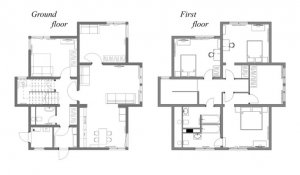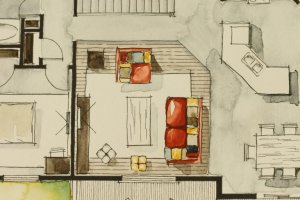Taking Out a Wall: How to Know if a Wall is Load-Bearing

You can determine if a wall in your home is load-bearing by analyzing the structure the same way a builder would.
We often want to remodel our homes and improve the look of it. Before you can do that, you need to know a few things about taking out walls – like if a wall is load-bearing.
A home’s structure can be complex. However, figuring out which walls support the house doesn’t have to be difficult. These are the walls that really shouldn’t be touched.
Knowing more about architecture can help you plan your home as well. This will help you come up with more ideas when it comes to remodeling.
Taking out walls: observation and study
First, you have to know a lot about the walls and supports of your home. Making a plan of all of the home’s parts and rooms can be really helpful.

Having an aerial view, with notes and arrows that point to load-bearing walls, will be very helpful in your studies.
It would also be extremely helpful to get the house’s original plans made by the architect, if possible. You may even be surprised by how the house is set up and organized.
-Doubt and study, study and know.-
Determining which walls are load-bearing
Walls are separators that divide homes into different sectors. However, some simply partition walls while others are load-bearing.
The latter, along with other building elements like lintels, columns, etc., are vital for structural support. Knocking down any of these supports can cause the house to collapse.

The walls that surround the house enclose the space from the outside, so they fulfill a load function. They also insulate the home thermally and acoustically.
These are three clues to help you out:
- Separation of load-bearing walls: check the distance between these walls, as well as between the walls that enclose the home.
- Thickness: they are usually noticeably thicker than partition walls.
- Walls in the center of the house: It’s very likely that these walls are load-bearing.
The same walls on different floors
Walls, from top to bottom, can have the same distribution. That’s why you should check if your home has the same walls on different floors.
If the walls are in the same places on different floors, then they’re load-bearing. Non-structural walls, on the other hand, can be placed anywhere.

From the basement to the attic, you’ll definitely find walls like this in the house. However, you may find that they’re not distributed in the same way. That’s when you can figure out where the walls are, and which are load-bearing, so you can take some out.
-Investigate more than just your own home to become more knowledgeable on the topic-
Beams next to the wall
Beams are used as supporting elements and are sometimes visible. Their length and durability allow them to sustain and to be sustained.
They’re usually close to load-bearing walls. So, you can use beams as another clue for which walls you can take out.

However, beams are nothing without walls. Both are necessary for the architrave system used throughout history.
Guess if they’re dividing walls
Many of the walls in our homes are just dividing walls. They usually delimit rooms and make hallways. Therefore, it’s easy to tell which walls are just for dividing spaces in the home.
Hallways are usually made of these structural elements. They are thin (thinner than load-bearing walls) and can be removed or altered. Or, in another situation, can be completely taken out.
Also, these dividing walls usually have open spaces in them, like doors.

By lightly knocking on the wall, you can check if it’s solid or hollow. If it sounds hollow, then it’s just a dividing wall.
Finally, keep this in mind: these walls usually aren’t found next to the perimeter of the stairs.
-You can tell if a wall is load-bearing or not depending on how robust the wall is when you knock on it-
Conclusion
Look at the structure of your home. Observe it, study it and make your determinations based on your findings. This is the best way to find an answer to your question.
You can determine if a wall in your home is load-bearing by analyzing the structure the same way a builder would.
We often want to remodel our homes and improve the look of it. Before you can do that, you need to know a few things about taking out walls – like if a wall is load-bearing.
A home’s structure can be complex. However, figuring out which walls support the house doesn’t have to be difficult. These are the walls that really shouldn’t be touched.
Knowing more about architecture can help you plan your home as well. This will help you come up with more ideas when it comes to remodeling.
Taking out walls: observation and study
First, you have to know a lot about the walls and supports of your home. Making a plan of all of the home’s parts and rooms can be really helpful.

Having an aerial view, with notes and arrows that point to load-bearing walls, will be very helpful in your studies.
It would also be extremely helpful to get the house’s original plans made by the architect, if possible. You may even be surprised by how the house is set up and organized.
-Doubt and study, study and know.-
Determining which walls are load-bearing
Walls are separators that divide homes into different sectors. However, some simply partition walls while others are load-bearing.
The latter, along with other building elements like lintels, columns, etc., are vital for structural support. Knocking down any of these supports can cause the house to collapse.

The walls that surround the house enclose the space from the outside, so they fulfill a load function. They also insulate the home thermally and acoustically.
These are three clues to help you out:
- Separation of load-bearing walls: check the distance between these walls, as well as between the walls that enclose the home.
- Thickness: they are usually noticeably thicker than partition walls.
- Walls in the center of the house: It’s very likely that these walls are load-bearing.
The same walls on different floors
Walls, from top to bottom, can have the same distribution. That’s why you should check if your home has the same walls on different floors.
If the walls are in the same places on different floors, then they’re load-bearing. Non-structural walls, on the other hand, can be placed anywhere.

From the basement to the attic, you’ll definitely find walls like this in the house. However, you may find that they’re not distributed in the same way. That’s when you can figure out where the walls are, and which are load-bearing, so you can take some out.
-Investigate more than just your own home to become more knowledgeable on the topic-
Beams next to the wall
Beams are used as supporting elements and are sometimes visible. Their length and durability allow them to sustain and to be sustained.
They’re usually close to load-bearing walls. So, you can use beams as another clue for which walls you can take out.

However, beams are nothing without walls. Both are necessary for the architrave system used throughout history.
Guess if they’re dividing walls
Many of the walls in our homes are just dividing walls. They usually delimit rooms and make hallways. Therefore, it’s easy to tell which walls are just for dividing spaces in the home.
Hallways are usually made of these structural elements. They are thin (thinner than load-bearing walls) and can be removed or altered. Or, in another situation, can be completely taken out.
Also, these dividing walls usually have open spaces in them, like doors.

By lightly knocking on the wall, you can check if it’s solid or hollow. If it sounds hollow, then it’s just a dividing wall.
Finally, keep this in mind: these walls usually aren’t found next to the perimeter of the stairs.
-You can tell if a wall is load-bearing or not depending on how robust the wall is when you knock on it-
Conclusion
Look at the structure of your home. Observe it, study it and make your determinations based on your findings. This is the best way to find an answer to your question.







